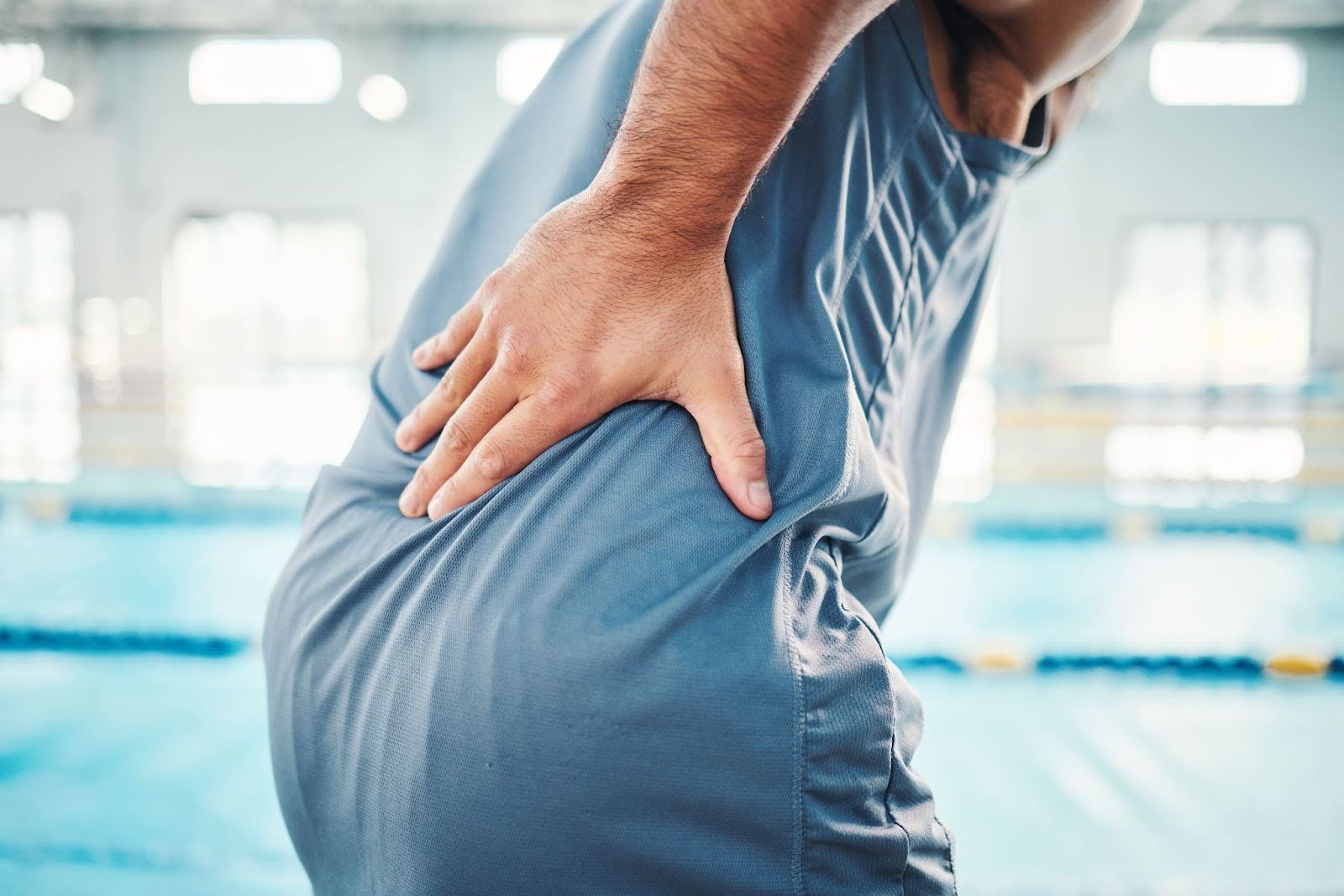Top Categories
Back Pain in Athletes
Back pain is a common ailment among athletes, often resulting from the physical demands and repetitive stressors of their sports. Athletes are prone to a range of back issues due to the intense and frequent physical activity that characterises their training and competition. This pain can range from a mild, nagging ache to severe, debilitating discomfort, potentially impacting performance and quality of life.
Stretches To Relieve Back Pain
Regularly stretching while focusing on targeted muscles can help alleviate back pain and improve flexibility in athletes.
- Child’s Pose Stretch: Targets the erector spinae, which runs along your spine, and the latissimus dorsi of the lower back. Begin by kneeling on a mat with your knees hip-width apart. Sit back on your heels, then lean forward to rest your forehead on the floor, stretching your arms out in front. Hold this pose, feeling a gentle stretch along your spine and shoulders.
- Cat-Cow Stretch: Focuses on the entire spine, including the cervical, thoracic, and lumbar regions. Start on all fours with your wrists directly under your shoulders and knees under your hips. For the Cat pose, arch your back upwards, tucking your chin to your chest. Transition to the Cow pose by dipping your back downwards, lifting your head and tailbone towards the sky. Alternate between these poses, moving smoothly.
- Knee-to-Chest Stretch: Primarily targets the lumbar region. Lie on your back with both knees bent and feet flat on the floor. Bring one knee to your chest, clasping your hands around your shin, while keeping the other foot flat. Gently pull the knee closer to your chest, feeling a stretch in your lower back. Repeat with the other leg.
- Seated Spinal Twist: Stretches the muscles of the lower back, particularly the obliques. Sit on the floor with your legs extended. Bend one knee and place the foot outside the opposite thigh. Place your opposite arm around the bent knee and twist your torso towards the bent knee. Hold the stretch and then switch sides.
- Pelvic Tilt Exercise: Engages and strengthens the abdominal muscles, which support the lower back. Lie on your back with your knees bent and feet flat on the floor. Tighten your abdominal muscles, pressing your lower back into the floor. Hold for a few seconds, then relax.
- Hamstring Stretch: Although primarily targeting the hamstrings, this stretch indirectly benefits the lower back by reducing muscle tightness that can contribute to back pain. Lie on your back, lift and straighten one leg upwards. Using your hands, gently pull the leg towards you, keeping it straight. You should feel a stretch along the back of your leg.
- Piriformis Stretch: Targets the piriformis muscle in the buttock, which can impact the sciatic nerve and cause back pain. Lie on your back with both knees bent. Cross one leg over the other so your ankle rests on the bent knee. Gently pull the uncrossed leg towards your chest, stretching the buttock of the crossed leg.
Exercises for Strengthening the Back
Strengthening the back muscles helps to alleviate existing back pain and prevent its recurrence. The following exercises are designed to strengthen the various muscle groups supporting the spine, enhancing an athlete’s back health and resilience.
- Plank: A fundamental core-strengthening exercise, the plank targets not just the abdominal muscles but also the back. By maintaining a straight line with the body, from head to heels, and holding this position, it engages the entire core.
- Bird Dog Exercise: This exercise improves lower back stability. From a hands-and-knees position, extend one arm forward while stretching the opposite leg back. This engages the back muscles and improves balance.
- Bridges: Lie on your back with knees bent and feet flat on the floor. Lift the hips to create a straight line from the knees to the shoulders, engaging the glutes and lower back.
- Superman Exercise: Lying face down, extend your arms in front of you and lift your chest, arms, and legs off the ground. This movement targets the upper and lower back, improving posture and back strength.
- Wall Sits: Stand with your back against a wall, then slide down into a sitting position with your thighs parallel to the floor. This engages the back and core muscles while also strengthening the legs.
- Deadlifts: With proper form, deadlifts are an effective exercise for strengthening the lower back, glutes, and hamstrings. It’s essential to use a manageable weight and to maintain the correct form to avoid injury.
- Lat Pulldowns: This exercise targets the upper back, specifically the latissimus dorsi. Using a resistance band or a lat pulldown machine, pull the weight down in front of you while keeping your back straight.
When to Seek Professional Medical Advice for Back Pain
While many cases of back pain in athletes can be managed through stretching, exercise, and self-care, there are instances where seeking professional medical advice is necessary.
- Persistent Pain: If back pain persists for more than a few weeks despite self-care measures, it’s advisable to consult your sports medicine specialist. Persistent pain may indicate an underlying issue that requires medical intervention.
- Severe Pain: Intense, debilitating back pain, especially if it appears suddenly, warrants immediate medical attention. This could be a sign of a serious injury or condition.
- Neurological Symptoms: Symptoms such as numbness, tingling, weakness in the limbs, or changes in bowel or bladder function, suggest nerve involvement and should be evaluated by your sports medicine specialist.
- Pain After Injury: If back pain follows a specific injury, such as a fall or collision, a sports medicine specialist should assess the injury to rule out fractures, dislocations, or other acute injuries.
- Unexplained Symptoms: Accompanying symptoms like unexplained weight loss, fever, or chills alongside back pain could indicate an infection or other systemic issue and should be promptly evaluated.
- Impact on Daily Activities: If back pain significantly hinders daily activities or athletic performance, a consultation with your sports medicine specialist can provide a targeted treatment plan and help in understanding the cause.
- Recurrent Pain: Athletes who experience recurrent episodes of back pain should seek professional advice to identify potential chronic issues and receive guidance on long-term management strategies.




